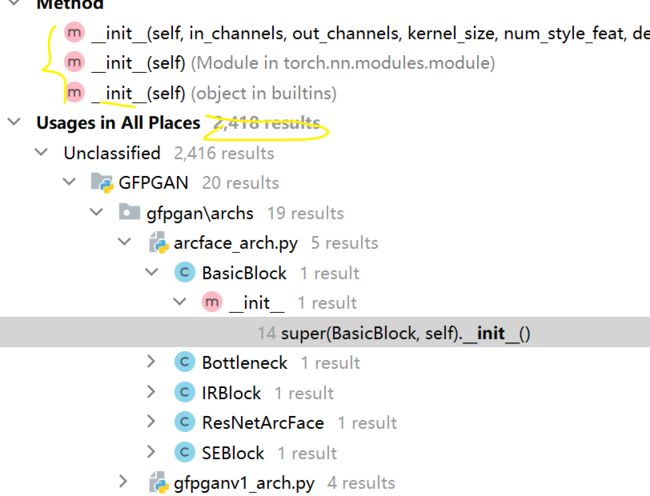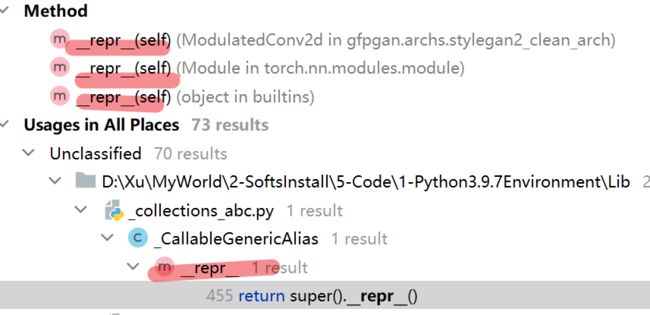2021SC@SDUSC 开源项目GFPGAN-3-2021-10-15-class ModulatedConv2d(nn.Module)分析
2021SC@SDUSC
目录
- 一、分析的代码片段
-
- 1、代码展示
- 2、代码作用
- 3、代码原理细究
-
- 1)__init__()方法
-
- in_channels:
- out_channels
- kernel_size
- demodulate=True
- sample_mode
- eps
- 2) forward(self, x, style)方法
- 3)__repr__(self):方法
- 二、类NormStyleCode在项目中的具体应用
-
-
- 1)__init__()方法
- 2) forward(self, x, style)方法
- 3)__repr__(self):方法
-
- 三、总结感悟
一、分析的代码片段
1、代码展示
class ModulatedConv2d(nn.Module):
"""Modulated Conv2d used in StyleGAN2.
There is no bias in ModulatedConv2d.
Args:
in_channels (int): Channel number of the input.
out_channels (int): Channel number of the output.
kernel_size (int): Size of the convolving kernel.
num_style_feat (int): Channel number of style features.
demodulate (bool): Whether to demodulate in the conv layer.
Default: True.
sample_mode (str | None): Indicating 'upsample', 'downsample' or None.
Default: None.
eps (float): A value added to the denominator for numerical stability.
Default: 1e-8.
"""
def __init__(self,
in_channels,
out_channels,
kernel_size,
num_style_feat,
demodulate=True,
sample_mode=None,
eps=1e-8):
super(ModulatedConv2d, self).__init__()
self.in_channels = in_channels
self.out_channels = out_channels
self.kernel_size = kernel_size
self.demodulate = demodulate
self.sample_mode = sample_mode
self.eps = eps
# modulation inside each modulated conv
self.modulation = nn.Linear(num_style_feat, in_channels, bias=True)
# initialization
default_init_weights(self.modulation, scale=1, bias_fill=1, a=0, mode='fan_in', nonlinearity='linear')
self.weight = nn.Parameter(
torch.randn(1, out_channels, in_channels, kernel_size, kernel_size) /
math.sqrt(in_channels * kernel_size**2))
self.padding = kernel_size // 2
def forward(self, x, style):
"""Forward function.
Args:
x (Tensor): Tensor with shape (b, c, h, w).
style (Tensor): Tensor with shape (b, num_style_feat).
Returns:
Tensor: Modulated tensor after convolution.
"""
b, c, h, w = x.shape # c = c_in
# weight modulation
style = self.modulation(style).view(b, 1, c, 1, 1)
# self.weight: (1, c_out, c_in, k, k); style: (b, 1, c, 1, 1)
weight = self.weight * style # (b, c_out, c_in, k, k)
if self.demodulate:
demod = torch.rsqrt(weight.pow(2).sum([2, 3, 4]) + self.eps)
weight = weight * demod.view(b, self.out_channels, 1, 1, 1)
weight = weight.view(b * self.out_channels, c, self.kernel_size, self.kernel_size)
if self.sample_mode == 'upsample':
x = F.interpolate(x, scale_factor=2, mode='bilinear', align_corners=False)
elif self.sample_mode == 'downsample':
x = F.interpolate(x, scale_factor=0.5, mode='bilinear', align_corners=False)
b, c, h, w = x.shape
x = x.view(1, b * c, h, w)
# weight: (b*c_out, c_in, k, k), groups=b
out = F.conv2d(x, weight, padding=self.padding, groups=b)
out = out.view(b, self.out_channels, *out.shape[2:4])
return out
def __repr__(self):
return (f'{self.__class__.__name__}(in_channels={self.in_channels}, '
f'out_channels={self.out_channels}, '
f'kernel_size={self.kernel_size}, '
f'demodulate={self.demodulate}, sample_mode={self.sample_mode})')
2、代码作用
从关键函数forward(self, x, style):来看,这个模块的作用就是将对应的张量x规范化,
并且返会相应的卷积;
本部分模块涉及神经网络
3、代码原理细究
1)init()方法
参考自 相关文章
几个参数解析:
in_channels,
out_channels,
kernel_size,
num_style_feat
demodulate=True,
sample_mode=None,
eps=1e-8
in_channels:
这个很好理解,就是输入的四维张量[N, C, H, W]中的C了,即输入张量的channels数。
这个形参是确定权重等可学习参数的shape所必需的。
out_channels
期望的四维输出张量的channels数,不再多说。
kernel_size
卷积核的大小,一般我们会使用5x5、3x3这种左右两个数相同的卷积核,
因此这种情况只需要写kernel_size = 5这样的就行了。
如果左右两个数不同,比如3x5的卷积核,那么写作kernel_size = (3, 5),注意需要写一个tuple,而不能写一个列表(list)
demodulate=True
demodulate (bool): Whether to demodulate in the conv layer.
Default: True.
sample_mode
sample_mode (str | None): Indicating 'upsample', 'downsample' or None.
Default: None.
eps
eps (float): A value added to the denominator for numerical stability.
Default: 1e-8.
2) forward(self, x, style)方法
*作用:同类NormStyleCode-forward(self, x):方法类似,规范图片的相关格式,
返回out{out = out.view(b, self.out_channels, *out.shape[2:4])}信息
也就是 Tensor: Modulated tensor after convolution
*关键名词
weight:pytorch 权重
3)repr(self):方法
作用:对self对象进行几个维度的变量修改
从代码可以看出:
(f'{self.__class__.__name__}(in_channels={self.in_channels}, '
f'out_channels={self.out_channels}, '
f'kernel_size={self.kernel_size}, '
f'demodulate={self.demodulate}, sample_mode={self.sample_mode})')
二、类NormStyleCode在项目中的具体应用
1)init()方法
相当普遍的一个修改维度参数的方法
2) forward(self, x, style)方法
只在类内定义过
3)repr(self):方法
三、总结感悟
1、代码出现许多不太明白的变量和公式,但只是研究代码作用,内部细节不必理会
2、内容涉及pytorch ,有必要对深度学习方面的知识做个大概的理解

